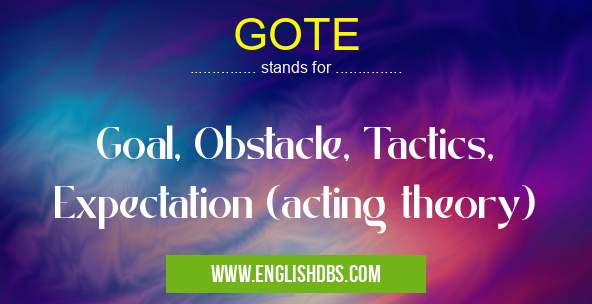What does GOTE mean in PERFORMING ARTS
GOTE is an acronym for Goal, Obstacle, Tactics, Expectation (acting theory). The framework provides a structure for student actors to grow and develop their characters within a scene. By understanding the goal of the character and the obstacles placed in the way of achieving this goal, the actor can determine how to use specific tactics to create a believable acting performance. This explanation should provide an overview of GOTE and answer some frequently asked questions about it.

GOTE meaning in Performing Arts in Community
GOTE mostly used in an acronym Performing Arts in Category Community that means Goal, Obstacle, Tactics, Expectation (acting theory)
Shorthand: GOTE,
Full Form: Goal, Obstacle, Tactics, Expectation (acting theory)
For more information of "Goal, Obstacle, Tactics, Expectation (acting theory)", see the section below.
Essential Questions and Answers on Goal, Obstacle, Tactics, Expectation (acting theory) in "COMMUNITY»PERFART"
What is GOTE?
GOTE stands for Goal, Obstacle, Tactics, Expectation (acting theory). It is an acting methodology that provides guidance on how to create believable characters by exploring their goals and obstacles they must face to reach them.
How does GOTE help actors develop characters?
Through GOTE, actors are encouraged to think deeply about their character's goal and what obstacles will stand in the way of achieving this goal. Then, the actor can explore different tactics that their character might use in order to overcome these obstacles and reach their desired outcome.
What is the importance of expectation in GOTE?
Expectation plays an important role in GOTE as it helps guide the actor's decisions about which actions their character should take in order to achieve their goals. By understanding what their character hopes or expects to happen, an actor can decide how they should approach each scene with more clarity and authenticity.
How do you apply GOTE when constructing a scene?
When constructing a scene using the GOTE methodology first consider your character's goal. What is it that they want? Next look at any possible obstacles that may stand in the way of achieving this goal (i.e., other characters or external forces). Finally decide upon appropriate tactics your character might use in order to overcome these obstacles and get closer to reaching their desired result.
How does having a better understanding of GOTE benefit acting performances?
Having a better understanding of GOTE ultimately results in stronger acting performances as it allows actors to better understand why characters make certain decisions during scenes. Additionally having insight into both a character's goals and expectations can lead to convincing dialogue delivery as well as believable emotional responses during key moments.
Final Words:
In summary, knowing one's purpose within any given scene is integral when developing believable characters within stage or screen performance contexts. Understanding how Goal, Obstacle, Tactics and Expectation work together towards creating engaging storytelling allows actors not just craft what they do but why they do it. Through mastery of this concept dramas become less ritualized conventions than dynamic expressions between players with interesting motivations; stories come alive driven by creative forces from all parties involved from director/actor/characters alike!
